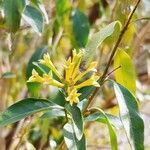Shrubs, pubescent on young growth, glabrescent. Petiole 1-1.4 cm; leaf blade ovate or elliptic, 4-7 × 2-4 cm. Inflorescences erect, terminal or axillary racemose panicles; bracts deciduous, leaflike, to 7 mm. Pedicel ca. 1 mm. Calyx campanulate, ca. 6 mm, sometimes with 5 prominent longitudinal ribs; teeth ca. 1 mm, often somewhat unequal. Corolla golden yellow, 1.4-2 cm, gradually expanded upwards, glabrous, lobes 3-4 mm. Filaments denticulate, pubescent at point of insertion. Berry white, ovoid, 7-11 mm; persistent calyx often splitting. Seeds ca. 4.
Shrub to c. 2 m high. Lvs glabrous. Petiole 1-5 cm long. Lamina 4-15 × 2-7 cm, oblong-ovate; base cuneate to truncate; apex shortly acuminate. Infl. paniculate; branches puberulent or glabrate; fls sessile or shortly pedicellate, scentless. Calyx tube 6-8 mm long; lobes subulate-acuminate, 0.7-2 mm long, ciliate in sinuses. Corolla 2-2.5 cm long, orange; tube ± cylindric-funnelform; lobes c. 3 mm long, puberulent inside, becoming strongly reflexed, acuminate. Fr. c. 1.5 × 2 cm, ± broadly ellipsoid, white; apex truncate.
Small tree or climbing shrub, 1.8-6.0 m high. Leaves lanceolate or ovate, up to 150 mm long, acute or acuminate. Inflorescence terminal, paniculate. Calyx up to 10 mm long. Corolla 20-25 mm long. Berries white. Flowers orange.


